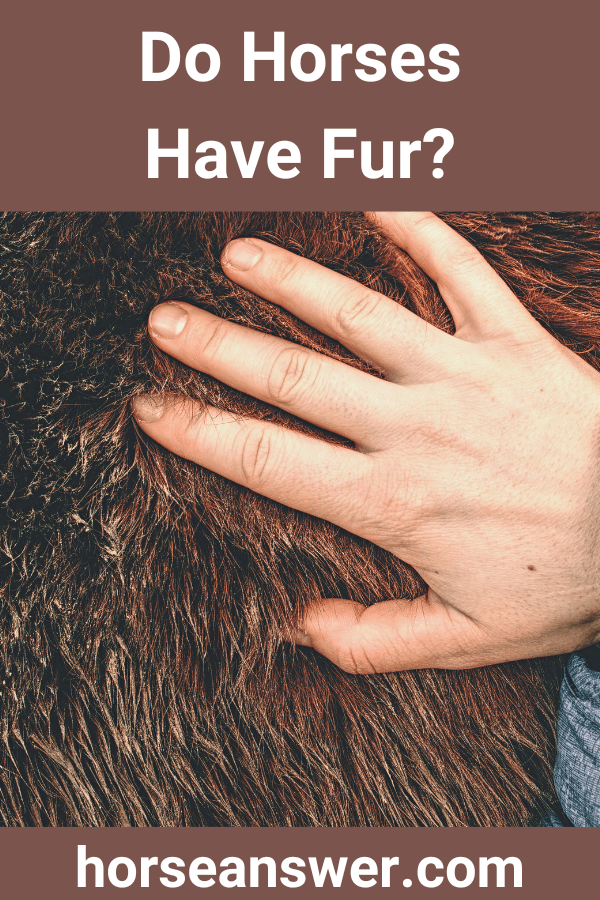Do Horses Have Fur? (Helpful Content!)
The answer is no, horses do not have fur. Instead, horses have hair. This is partly semantics, since air and fur are essentially the same thing on a molecular level. But there are several distinctions in the hair or fur animals have that direct how we refer to their coats.
It sounds complicated, but we will explain the similarities and differences below.
We will also examine the different types of hair and coats that horses have and how to care for them.

How are hair and fur different?
Structurally, hair and fur are the same thing.
Animal hair is made of keratin, and grows from a follicle beneath the surface of the skin.
Animals that are referred to as having hair will often have softer hair that can grow longer than an animal that has fur.
Fur is also frequently used for insulation to keep an animal at the appropriate temperature despite the environment.
Animals with coats of hair do get some protection from the elements, but they are not as capable of regulating their own temperatures.
What types of coats do horses have?
Horses’ hair comes in a variety of colors, and depending on the breed horses may have longer or shorter hair too.
Furthermore, much like pets you are more familiar with like dogs or cats, horses coats shed seasonally so that they have a coat that matches the temperature and environment they are in.
Some breeds of horses, like Shetland ponies or Icelandic horses, have much fluffier coats with longer hair, particularly in the winter.
Draft horses, like Fresians and Clydesdales, have trademark “feathers” on their feet; longer hair on the bottom halves of their legs.
If you look carefully at a horse’s coat, whether it is color, pattern, or thickness, you can discern a lot about their history and lineage!
Is a horse’s mane different from their coat?
At their root, a horse’s mane or tail is hair, just like the hair that covers their bodies.
However, there are some consistent differences.
Horse manes and tails are much longer and coarser than the hair on the rest of their bodies. A
dditionally, horse manes and tails are commonly a different color or shade from the rest of the horse.
Do horses need haircuts?
Generally, horses’ coats, manes, and tails will shed out as needed.
This is prompted seasonally by the change in the length of the day.
When horses are getting more or less sunlight due to the length of the day, it signals to their body to prepare to shed and grow their winter or summer coats.
However, some owners will trim their horse’s mane or tails to achieve a desired look or to keep them clean.
Tails can grow so long they may drag on the ground! And sometimes the forelock of their mane can fall in their eyes.
Owners will also trim their manes and tails to match the style of their riding discipline.
Owners may also clip their horse’s coat to keep them cool, tidy, or more easily cleaned.
Many horses will be clipped in a few established patterns in the winter because their coats can grow so thick.
When a horse works hard in these coats it can take significant time to safely cool and dry a horse out, prompting owners to use clippers to shorten their hair in the sweatiest sections.
Of course, this also means these owners are committed to helping regulate their horse’s temperature and comfort with the use of blankets and coolers, since they have removed some of their horse’s natural tools for regulating temperature.
How do you clean horses’ hair?
Cleaning horses, including their coats, manes, and tails, is simple – when the weather permits!
Horses benefit from baths, just like you or your pets do.
There are a variety of horse-specific shampoos, and some people have even used the most common brands for their own showers!
Many horses will get treated for skin conditions like dry skin or fungus, so medicated shampoos with antimicrobial effects are good to keep on hand.
Owners also of light-colored horses also have to contend with the dreaded staining that comes with horses who are prone to rolling in the mud (or worse.)
In this case, whitening shampoos can work wonders.
White hair on horses is likely to stain yellow, and whitening shampoos that have blue undertones help to counteract that yellow tone.
Why do some horses have curly hair?
There is one breed of horse that has distinctly curly hair, the Bashkir Curly.
They carry a gene that curls all the hairs on their body, including their coat (which looks a lot like fur in this case! But it is still called hair,) mane, tail, and even eyelashes.
Sometimes they will appear to have wavy hair with their summer coat and curlier hair in the winter.
The other reason you may see a horse with curly hair is more of a concern; horses with a condition called Cushings will also sport a curly coat.
Equine Cushings, or Pituitary Pars Intermedia Dysfunction (PPID) is a condition in some older horses where the pituitary gland does not function right.
Horses with Cushings will not shed their coats.
Additionally, while their body hair is curly, they will not have curled eyelashes or ears like the Bashkir Curly horses.
Because of the effects of the condition, they will lose muscle mass and seem sluggish, they may also go blind.